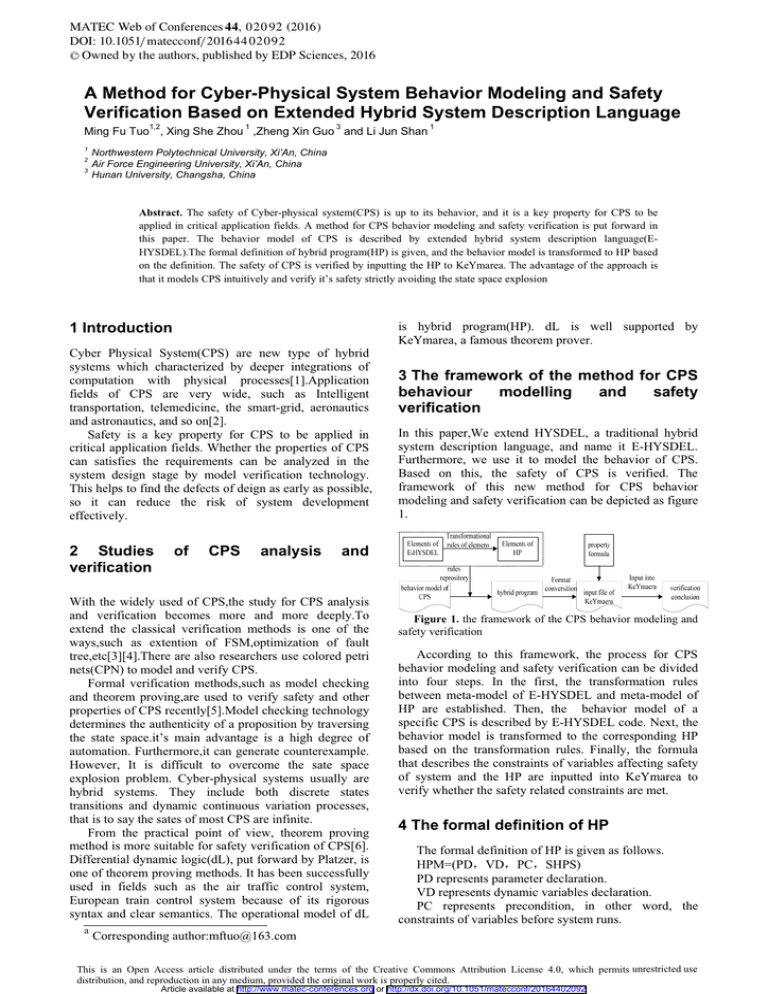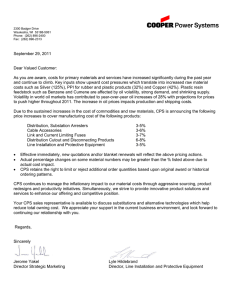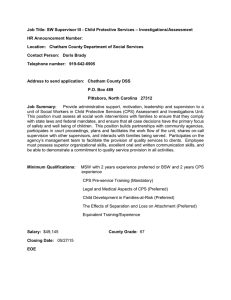A Method for Cyber-Physical System Behavior Modeling and Safety
advertisement

MATEC Web of Conferences 4 4, 0 2 0 92 (2016 )
DOI: 10.1051/ m atecconf/ 2016 4 4 0 2 0 92
C Owned by the authors, published by EDP Sciences, 2016
A Method for Cyber-Physical System Behavior Modeling and Safety
Verification Based on Extended Hybrid System Description Language
Ming Fu Tuo1,2, Xing She Zhou 1 ,Zheng Xin Guo 3 and Li Jun Shan 1
1
2
3
Northwestern Polytechnical University, Xi’An, China
Air Force Engineering University, Xi’An, China
Hunan University, Changsha, China
Abstract. The safety of Cyber-physical system(CPS) is up to its behavior, and it is a key property for CPS to be
applied in critical application fields. A method for CPS behavior modeling and safety verification is put forward in
this paper. The behavior model of CPS is described by extended hybrid system description language(EHYSDEL).The formal definition of hybrid program(HP) is given, and the behavior model is transformed to HP based
on the definition. The safety of CPS is verified by inputting the HP to KeYmarea. The advantage of the approach is
that it models CPS intuitively and verify it’s safety strictly avoiding the state space explosion
is hybrid program(HP). dL is well supported by
KeYmarea, a famous theorem prover.
1 Introduction
Cyber Physical System(CPS) are new type of hybrid
systems which characterized by deeper integrations of
computation with physical processes[1].Application
fields of CPS are very wide, such as Intelligent
transportation, telemedicine, the smart-grid, aeronautics
and astronautics, and so on[2].
Safety is a key property for CPS to be applied in
critical application fields. Whether the properties of CPS
can satisfies the requirements can be analyzed in the
system design stage by model verification technology.
This helps to find the defects of deign as early as possible,
so it can reduce the risk of system development
effectively.
2 Studies
verification
of
CPS
analysis
In this paper,We extend HYSDEL, a traditional hybrid
system description language, and name it E-HYSDEL.
Furthermore, we use it to model the behavior of CPS.
Based on this, the safety of CPS is verified. The
framework of this new method for CPS behavior
modeling and safety verification can be depicted as figure
1.
and
With the widely used of CPS,the study for CPS analysis
and verification becomes more and more deeply.To
extend the classical verification methods is one of the
ways,such as extention of FSM,optimization of fault
tree,etc[3][4].There are also researchers use colored petri
nets(CPN) to model and verify CPS.
Formal verification methods,such as model checking
and theorem proving,are used to verify safety and other
properties of CPS recently[5].Model checking technology
determines the authenticity of a proposition by traversing
the state space.it’s main advantage is a high degree of
automation. Furthermore,it can generate counterexample.
However, It is difficult to overcome the sate space
explosion problem. Cyber-physical systems usually are
hybrid systems. They include both discrete states
transitions and dynamic continuous variation processes,
that is to say the sates of most CPS are infinite.
From the practical point of view, theorem proving
method is more suitable for safety verification of CPS[6].
Differential dynamic logic(dL), put forward by Platzer, is
one of theorem proving methods. It has been successfully
used in fields such as the air traffic control system,
European train control system because of its rigorous
syntax and clear semantics. The operational model of dL
a
3 The framework of the method for CPS
behaviour
modelling
and
safety
verification
Figure 1. the framework of the CPS behavior modeling and
safety verification
According to this framework, the process for CPS
behavior modeling and safety verification can be divided
into four steps. In the first, the transformation rules
between meta-model of E-HYSDEL and meta-model of
HP are established. Then, the behavior model of a
specific CPS is described by E-HYSDEL code. Next, the
behavior model is transformed to the corresponding HP
based on the transformation rules. Finally, the formula
that describes the constraints of variables affecting safety
of system and the HP are inputted into KeYmarea to
verify whether the safety related constraints are met.
4 The formal definition of HP
The formal definition of HP is given as follows.
HPM=(PDˈVDˈPCˈSHPS)
PD represents parameter declaration.
VD represents dynamic variables declaration.
PC represents precondition, in other word, the
constraints of variables before system runs.
Corresponding author:mftuo@163.com
This is an Open Access article distributed under the terms of the Creative Commons Attribution License 4.0, which permits XQUHVWULFWHGXVH
distribution, and reproduction in any medium, provided the original work is properly cited.
Article available at http://www.matec-conferences.org or http://dx.doi.org/10.1051/matecconf/20164402092
MATEC Web of Conferences
SHPS represent the set of sub hybrid program. Each
SHP is defined as follows.
SHP=( MSˈDTSˈCTS)
MS represents set of discrete states.
DTS represents set of transitions of discrete states,
that is transitions between modes.
CTS represents set of dynamic processes, it describes
the continuous change in a single mode.
Some transformational rules are set up based on this
formal definition.
5 Application case
Room temperature control system is one of typical
CPS(Fig 2).There two persons, a heater, a air
conditioning, a window in room. These equipments can
affect the room temperature.T1 represents the
temperature of place where person 1 stay.T2 represents
the temperature of place where person 2 stay. Tamb
represents the temperature outside the window. Uhot
represents heater power flow when it is on. Ucold
represents air conditioning power flow when it is on.
The person 1 turns the heater(air conditioning) on
whenever he is cold(heat).If person 2 is cold he turns the
heater on unless person 1 is heat. If person 2 is heat he
turns the air conditioning on unless person 1 is cold.
Otherwise, heater and air conditioning are off.
Figure 2. the room temperature system
The changes of T1 and T2 can be expressed by the
following equations.
T1Ą= -alpha1*(T1-Tamb)+k1*(uhot-ucold)
T2Ą= -alpha2*(T2-Tamb)+k2*(uhot-ucold)
In these equations, Ts=0.5ˈalpha1 = 1ˈalpha2 =
0.5ˈk1 = 0.8ˈk2 = 0.4ˈThot1 = 30ˈTcold1 = 15ˈ
Thot2 = 35ˈTcold2 = 10ˈUc = 2ˈUh = 2.
We will verify the conclusion that state 10İT1,T2İ
15 is not reachable on condition that 10İTambİ30 and
the initial state is 35İT1,T2İ40.
The behavior model of temperature control system is
described by the following E-HYSDEL codes.
SYSTEM heatcool {
INTERFACE {
STATE {
REAL T1 [-10,50];
REAL T2 [-10,50];
}
INPUT { REAL Tamb [-10,50]; }
OUTPUT {
REAL y1;
REAL y2;
}
PARAMETER
{
REAL Ts=0.5, alpha1=1, alpha2=0.5, k1=0.8,
k2=0.4;
REAL Thot1=30, Tcold1=15, Thot2=35, Tcold2=10,
Uc=2, Uh=2;
}
}
IMPLEMENTATION {
AUX {
REAL uhot, ucold,t;
BOOL hot1, hot2, cold1, cold2;
}
AD { hot1 = T1>=Thot1;
hot2 = T2>=Thot2;
cold1 = T1<=Tcold1;
cold2 = T2<=Tcold2;
}
DA { uhot = {IF cold1 | (cold2 & ~hot1) THEN Uh
ELSE 0
};
ucold = {IF hot1 | (hot2 & ~cold1) THEN Uc ELSE
0}; }
CONTINUOUS {
T1 = T1+Ts*(-alpha1*(T1-Tamb) +k1*(uhotucold));
T2 = T2+Ts*(-alpha2*(T2-Tamb) +k2*(uhotucold)); }
OUTPUT {y1=T1;
y2=T2;
}
}
}
The behavior model is transformed to the following
HP based on the former transformational rules.
heatcoolį˄S1ĤS2˅*
S1į(
Tamb=*;?(Tambı10ġTambİ30);
if((T1İTcold1)Ģ(T2İTcold2ġ¬T1ıThot1))
uhot:=Uh;
else
uhot:=0;
if((T1ıThot1)Ģ(T2ıThot2ġ¬T1İTcold1))
ucold:=Uc;
else
ucold:=0;
T1Ą= -alpha1*(T1-Tamb)+k1*(uhot-ucold),tĄ=1 ;
)
S2į(
Tamb=*;?(Tambı10ġTambİ30);
if((T1İTcold1)Ģ(T2İTcold2ġ¬T1ıThot1))
uhot:=Uh;
else
uhot:=0;
if((T1ıThot1)Ģ(T2ıThot2ġ¬T1İTcold1))
ucold:=Uc;
else
02092-p.2
ICEICE 2016
ucold:=0;
T2Ą= -alpha2*(T2-Tamb)+k2*(uhot-ucold),tĄ=1 ;
)
Finally, the safety of the system is specified by the
formulation ˷ heatcool* ˹ , where is initial
condition, and is the conclusion to be verified.
verification used less steps and avoid the state space
explosion.
6 Conclusion
The main idea of the given method for behavior modeling
and safety verification of CPS is that modeling the
behavior of CPS by hybrid automata, which is described
by E-HYSDEL language, then transform this model to a
corresponding dL model, described by HP, and verify the
safety of the dL model by means of KeYmaera.
The advantage of this method is that it models CPS
intuitively and verifies it’s safety strictly. The method can
also be used to verify other property of CPS, such as realtime, reliability.
References
1.
Lee, E. CPS foundations. Proceedings of the 47th
ACM/IEEE Design Automation Conference., 2010.
737742
(Tamb10ġTamb30)ġ(T135ġT140)ġT235
ġT240)
¬( (T110ġT115)Ģ(T210ġT215))
The conclusion is verified in KeYmaera after many
steps. The results shows that this method for safety
He, J. F. Cyber-physical systems. Communications
of the China Computer Federation, 2010, 6(1):
2529
3. Leonardi, F., Pinto, A., and Carloni, L. P. Synthesis
of distributed execution platforms for cyber-physical
systems with applications to high-performance
buildings. In: Proceedings of the IEEE/ACM
International Conference on Cyber-Physical Systems.
Chicago, USA: IEEE, 2011. 215224.
4. Jha, S., Gulwani, S., Sanjit, A., and Seshia, A.
Synthesizing Switching Logic for Safety and DwellTime Requirements. EECS Department, University
of California, Berkeley, Technical Report No.
UCB/EECS-2010-28, 2010.
5. Zhu, M., Li, B. X., and Chen, Q. Q., transforming
hybridUML to hybrid program for CPS property
verification. Electronic journals, 2012ˈ40˄6˅˖
1126-1132.
6. Platzer ˈ A Logical Analysis of Hybrid Systems:
Proving Theorems for Complex Dynamics.
Heidelberg: Springer, 2010.Luigi T.De Luca,
Propulsion physics (EDP Sciences, Les Ulis, 2009)
2.
02092-p.3


